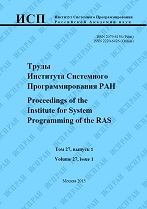|
Features of creating a mesh for modeling the icing process of a delta-wing with a complex shape
K. B. Koshelev, A. V. Osipov, S. V. Strijhak
Ivannikov Institute for System Programming of the RAS
Abstract:
The article deals with the problem of modeling the icing of a delta-wing of the X-59 demonstrator aircraft. Three variants of grids for 1.1, 3.8, 9.6 million cells are considered. Wing icing is modeled using the iceFoam solver developed as part of the OpenFOAM package. To solve the problem, two grids are used: the first in the outer region, the second for a liquid film near a solid. blockMesh and snappyHexMesh utilities as part of the OpenFOAM package are used to build the gas phase grid. The quality of the gas phase grid, determined by the standard checkMesh utility, meets all the requirements being checked. However, during the automatic construction of the liquid film mesh, cells with unsatisfactory parameters may be formed, which, for example, include the requirement of limited non-orthogonality of the faces. In this regard, a new algorithm for excluding low-quality calculation cells is being discussed. The simulations were carried out for the X-59 demonstrator wing models on a scale of 1:25 and 1:1 for the case of loose ice. For different-scale models, the invariance of the Reynolds and Mach numbers was ensured. At the same time, the constant parameters in the dimensional form were the water content of the air and the median diameter of water droplets. Patterns of ice formation on the upper and lower parts of the wing were obtained. It is shown that the icing regions of different-scale wing models can differ significantly even when the dimensionless similarity complexes for the gas phase coincide. It is concluded that many experimental and calculated results on the icing of small profiles are difficult to transfer to full-scale profiles. The simulation was performed on the ISP RAS cluster using 48 or 96 processor cores.
Keywords:
icing, wing, modelling, mesh, cell, solver, algorithm
Citation:
K. B. Koshelev, A. V. Osipov, S. V. Strijhak, “Features of creating a mesh for modeling the icing process of a delta-wing with a complex shape”, Proceedings of ISP RAS, 34:5 (2022), 215–226
Linking options:
https://www.mathnet.ru/eng/tisp732 https://www.mathnet.ru/eng/tisp/v34/i5/p215
|

| Statistics & downloads: |
| Abstract page: | 41 | | Full-text PDF : | 22 |
|




 Contact us:
Contact us: Terms of Use
Terms of Use
 Registration to the website
Registration to the website Logotypes
Logotypes









 Citation in format
Citation in format 